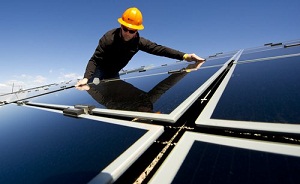Reviewing last week's solar energy news
 The leaves may be falling, but the solar industry keeps moving forward. Among other things, last week saw unveiling of the world’s newest, largest commissioned solar plant. Not even the failure of Solyndra has turned the majority of the U.S. public against solar. And with events like the Solar Decathlon and the National Solar Tour gaining popularity, who can blame them. Also, U.S. manufacturers are starting to push back against cheap Chinese modules that have dropped the cost of solar significantly but may encroach on unfair trade practices and patents.
The leaves may be falling, but the solar industry keeps moving forward. Among other things, last week saw unveiling of the world’s newest, largest commissioned solar plant. Not even the failure of Solyndra has turned the majority of the U.S. public against solar. And with events like the Solar Decathlon and the National Solar Tour gaining popularity, who can blame them. Also, U.S. manufacturers are starting to push back against cheap Chinese modules that have dropped the cost of solar significantly but may encroach on unfair trade practices and patents.
Yes, it’s official, there’s now a photovoltaic array that broke the 100-megawatt barrier. The 166-megawatt German Senftenberg solar plant that was unveiled last week is now the world’s largest. It’s 1 megawatt bigger than the combined size last year’s record holders, the 80-megawatt Sarnia power plant in Ontario, Canada, and the 85-megawatt Montalto di Castro park in Lazio, Italy.
Google’s also “feeling lucky” on solar. The search engine giant established a new $75 million fund to support residential solar lease products, this time with a company called Clean Power Finance that will allow installers in certain markets offer customers a solar lease, while still retaining their brand on the installation.
U.S. solar manufacturers also are weighing their options in terms of legal and trade options they could possibly take to stave off, what’s increasingly being called unfair competition in the photovoltaic market. The Chinese photovoltaic manufacturing industry has flooded U.S. and international markets with cheap PV modules heavily subsidized by the country’s central government. However, they have yet to file any complaints against their Chinese counterparts.
The impact of the inexpensive Chinese modules have had a direct impact on U.S. manufacturers like Solyndra. The company recently declared bankruptcy because it couldn’t compete with the lower-cost silicon modules from China, and since it won government help through the 1705 Loan-Guarantee Program, the U.S. taxpayer may have to foot significant portions of the $535 million bill. Still, a new study finds that the U.S. hasn’t soured on solar. The study, jointly conducted by Democrat and Republican pollsters, found that twice as many U.S. citizens favor solar and clean energy than those who don’t.
The fall of Solyndra cast a pall over the entire 1705 loan guarantee program, which is supporting billions of dollars of projects throughout the U.S. Some companies won last minute approvals, some didn’t. But those that missed the deadlines or other requirements under 1705 may still be eligible for funds under another program.
Despite the loss of the 1705 program, internationally, companies are still looking to expand into the U.S. For instance, Antaris Solar, a vertically integrated German photovoltaic company, said it plans to expand its presence in the U.S. with a new facility in New Jersey, from which it will offer its modules as well as design services.
To help spread the further adoption of solar, there’s nothing like putting it square in the public’s eye. That’s why events like the Department of Energy’s Solar Decathlon are so important. And interest is growing. Despite the Decathlon’s troubles this year, it attracted more visitors than ever with 357,000 individual home visits over the course of a week.
Another great place to publicize solar is at sports venues. That’s why Michigan-based Ecology Center is pushing to install solar at Michigan Stadium, home to the Michigan Wolverines. The organization is circulating a petition to get solar installed on the largest football stadium in the U.S. And, with 4,000 signatures, it’s well on its way to its goal of 10,000.
Image courtesy of NREL.



